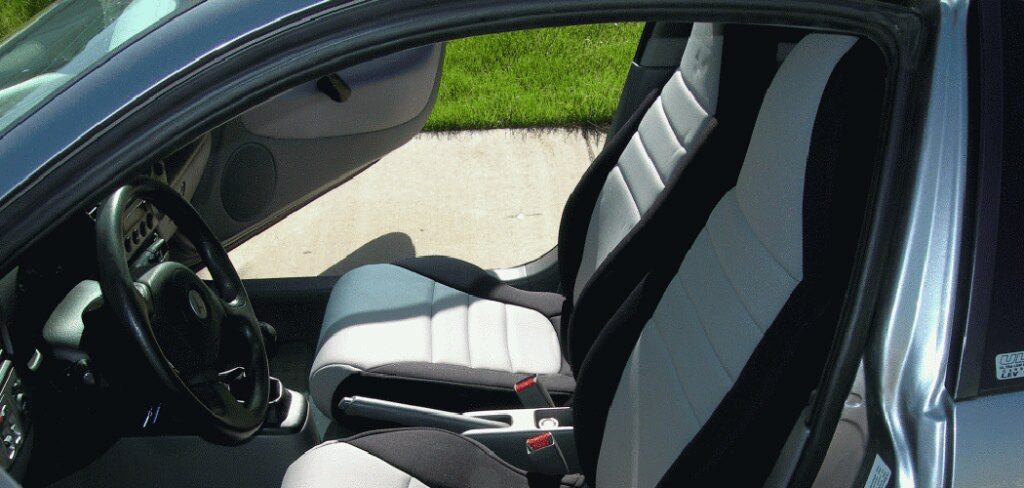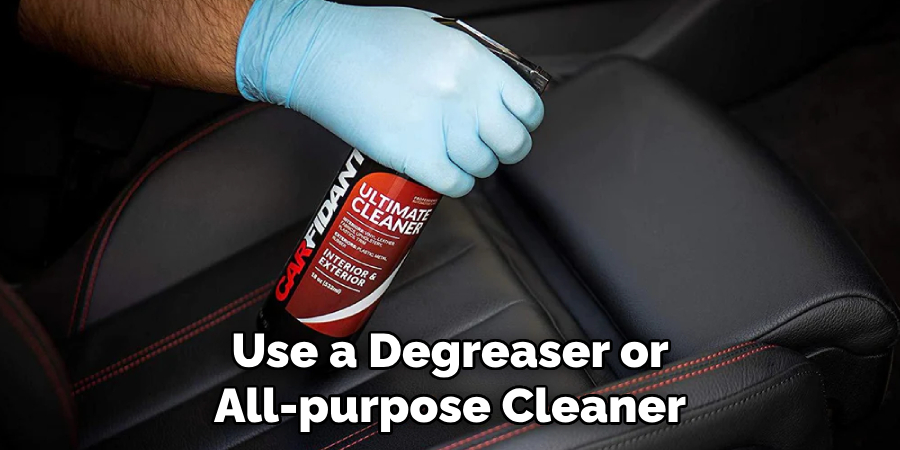If you’ve ever walked into your vehicle only to be greeted by the unpleasant smell of sweaty, dirty seat covers, then you know the struggle of keeping neoprene covers clean. Neoprene is an incredibly durable material that helps protect your vehicle’s seats from spills, dirt, sweat, and more. However, this rubberized fabric is also prone to absorbing odors if not cleaned properly.

Over time, neglecting to wash neoprene covers can turn your once-fresh-smelling car interior into an olfactory nightmare. But fret not – with the right cleaning products and techniques, you can banish those stinky seats for good. In this blog post, I’ll be sharing my simple yet effective method for how to clean neoprene seat covers and keeping them smelling fresh and looking new.
9 Best Methods on How to Clean Neoprene Seat Covers
1. Vacuum First:
Before you get started with any cleaning products, it’s essential to remove any loose debris and dirt from your neoprene seat covers. Use a vacuum cleaner with a soft brush attachment to gently go over the surface of the covers. This will help loosen and remove any crumbs or dirt particles that may have accumulated on the fabric.
2. Spot Clean Stains:
If your neoprene seat covers have any visible stains, it’s best to spot-clean them first before moving on to a more thorough cleaning. For this, you can use a mild detergent diluted with water or a specialized stain remover for neoprene fabric. Apply the cleaner directly to the stain and gently scrub in a circular motion using a soft-bristled brush. Once the stain has lifted, rinse the area with clean water and allow it to air dry.
3. Machine Wash:

Most neoprene seat covers are machine washable, so if you have removable covers, this is a quick and convenient way to clean them. Follow the manufacturer’s instructions for the appropriate water temperature and detergent to use. It’s best to wash neoprene covers on a gentle cycle with cold water to avoid shrinkage or damage to the fabric. This method is also great for removing any trapped odors from the covers.
4. Hand Wash:
If your neoprene seat covers are not machine washable or you prefer to hand wash them, you can still achieve excellent results with a gentle cleaning solution and soft brush. Fill a bucket with cold water and add a small amount of mild detergent or specialized neoprene cleaner. Submerge the covers in the water and gently scrub with a soft-bristled brush to remove any dirt or odors. Rinse thoroughly with clean water and allow them to air dry.
5. Use Baking Soda:
Baking soda is known for its odor-eliminating properties, making it an excellent natural alternative for removing unwanted smells from neoprene seat covers. Sprinkle baking soda over the covers and let it sit for a few hours or overnight. Then, use a vacuum cleaner to remove the powder, along with any trapped odors. Using baking soda is a great way to freshen up your neoprene seat covers in between washes.
6. Steam Clean:
Steam cleaning is another effective way to remove dirt and odors from neoprene seat covers. It’s recommended to use a handheld steam cleaner as it allows for more precise and controlled cleaning. Simply fill the steam cleaner with water, hold it a few inches away from the covers, and let the hot steam penetrate the fabric to loosen any dirt or odors. Then, use a clean cloth to wipe away any residue.

7. Use Vinegar Solution:
Vinegar is another natural cleaning agent that can help eliminate odors from neoprene seat covers. Mix equal parts water and white vinegar in a spray bottle, and spritz it over the covers. Let it sit for a few minutes before wiping it off with a clean cloth. The vinegar solution will help neutralize any unwanted smells while also disinfecting the covers.
8. Enzyme Cleaner:
Enzyme cleaners are specially formulated to break down and eliminate organic stains and odors, making them an excellent option for cleaning neoprene seat covers. Follow the instructions on the product label, and use a soft-bristled brush to work the cleaner into the fabric. Rinse thoroughly with clean water and allow it to air dry.
9. Protect with a Waterproofing Spray:
After cleaning and drying your neoprene seat covers, it’s a good idea to use a waterproofing spray to protect them from future spills and stains. This will also help prevent any odors from seeping into the fabric. Make sure to choose a spray specifically designed for neoprene material and follow the instructions carefully for the best results.
Following these methods on how to clean neoprene seat covers will not only keep them smelling fresh and looking new but also help prolong their lifespan. Remember to always check the manufacturer’s instructions for any special care or cleaning recommendations, and make sure to regularly clean your vehicle’s interior for a more pleasant driving experience. Happy cleaning!
Additional Tips and Tricks to Clean Neoprene Seat Covers
1. If you’re dealing with tough stains, try mixing a small amount of dish soap or laundry detergent with warm water and using the solution to scrub the affected area.

2. For particularly stubborn or set-in stains, you can use a degreaser or all-purpose cleaner specifically designed for automotive interiors.
3. To prevent discoloration, avoid leaving neoprene seat covers in direct sunlight for extended periods.
4. If you’re planning on machine-washing your neoprene seat covers, make sure to use a gentle cycle and cold water. Hot water can cause the neoprene to shrink or become misshapen.
5. Always air-dry your neoprene seat covers instead of using a dryer, as the high heat can damage the material.
6. When storing your neoprene seat covers, make sure they are completely dry to avoid mildew growth. You can also sprinkle baking soda on them before storing them to help absorb any lingering odors.
7. For regular maintenance, wipe down your neoprene seat covers with a damp cloth and allow them to air dry. This will help prevent dirt and grime from building up.
8. If you have pets, consider using a lint roller or pet hair remover to easily remove any pet hair from your neoprene seat covers.
9. Avoid using harsh chemicals or bleach on your neoprene seat covers, as they can damage the material and cause discoloration.
Following these tips and tricks will not only help keep your neoprene seat covers looking clean and new, but also extend their lifespan. With proper care, you can enjoy the comfort and durability of neoprene seat covers for years to come. Happy cleaning!
Frequently Asked Questions
Can I Machine Wash My Neoprene Seat Covers?
It is generally not recommended to machine wash neoprene seat covers as this may damage the material. Neoprene is a delicate fabric and can easily tear or warp in high heat, such as that of a washing machine.

How Often Should I Clean My Neoprene Seat Covers?
The frequency of cleaning neoprene seat covers will depend on your usage and personal preference. Some people prefer to clean them every few months, while others may clean them more frequently. It is recommended to remove any spills or stains as soon as possible to prevent permanent damage.
What Cleaning Products Should I Use?
When it comes to cleaning neoprene seat covers, it is important to use gentle and non-abrasive products. Harsh chemicals can damage the fabric and alter its appearance. Stick to mild soap or detergent and water for regular cleaning. For tougher stains, an upholstery cleaner or a mixture of vinegar and water can be used.
How Do I Clean Tough Stains?
If you have tough stains on your neoprene seat covers, it is best to spot-clean them first with a mild soap and water solution. Gently rub the stain in a circular motion until it lifts. If the stain persists, you can try using an upholstery cleaner or a mixture of vinegar and water.
Can I Use A Pressure Washer?
It is not recommended to use a pressure washer on neoprene seat covers as it may cause damage to the fabric. The high pressure can tear or warp the material, leaving it looking distorted and worn out.
How Do I Dry Neoprene Seat Covers?
After cleaning, it is important to properly dry neoprene seat covers. Avoid using high heat as this can damage the fabric. It is best to air-dry them in a well-ventilated area or use a fan or hairdryer in a cool setting. Do not put them in the dryer.
Conclusion
in conclusion, Knowing how to clean neoprene seat covers is essential to maintaining their appearance and longevity. It is important to use gentle and non-abrasive products, avoid high heat and pressure, and properly dry them after cleaning.
By following these tips and regularly cleaning your neoprene seat covers, you can keep them looking like new for years to come. Don’t forget to also refer to the manufacturer’s care instructions for specific guidance on cleaning and maintenance. Happy driving!

About
JeepFixes Team is a skilled author for Jeep Fixes, bringing 6 years of expertise in crafting a wide range of jeep fixes. With a strong background in jeep fixes work, JeepFixes Team’s knowledge spans various types of fixtures, from decorative pieces to functional hardware, blending precision with creativity. His passion for jeep fixes and design has made him a trusted resource in the industry.
Professional Focus:
Expert in Jeep Fixes : JeepFixes Team aesthetic specializes in creating durable and innovative jeep fixes, offering both appeal and functionality. His work reflects a deep understanding of jeep fixes techniques and materials.
Sustainability Advocate : He is dedicated to using sustainable practices, ensuring that every fixture is crafted with eco-friendly methods while maintaining high-quality standards.
In his writing for jeep fixes, JeepFixes Team provides valuable insights into the latest trends, techniques, and practical advice for those passionate about jeep fixes, whether they are professionals or DIY enthusiasts. His focus on combining artistry with engineering helps others discover the true potential of jeep in design.
